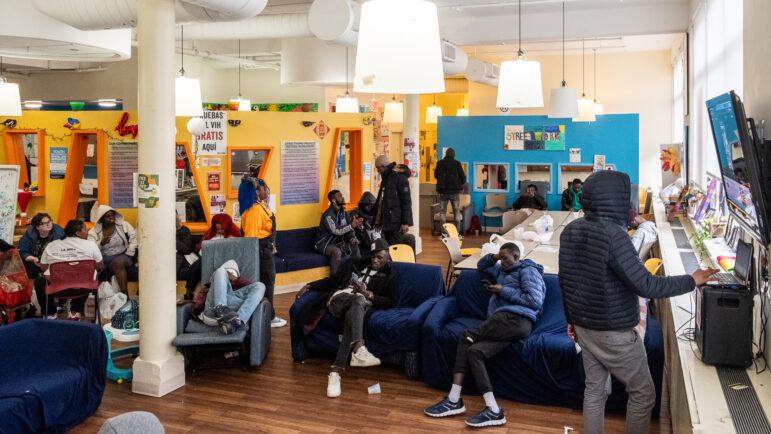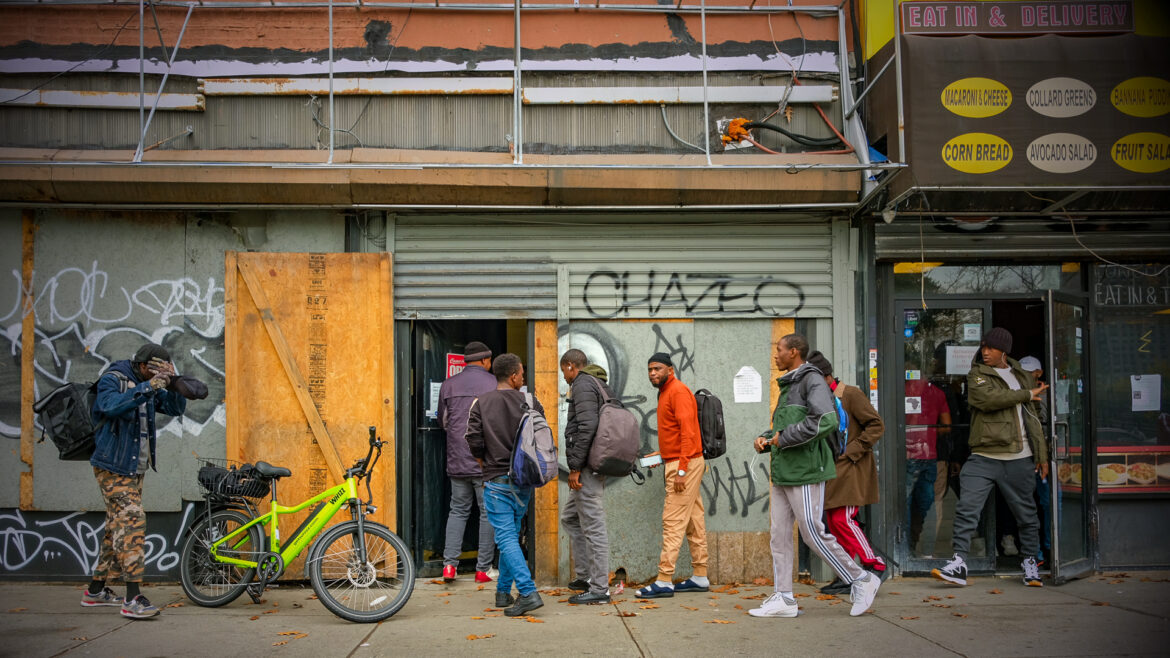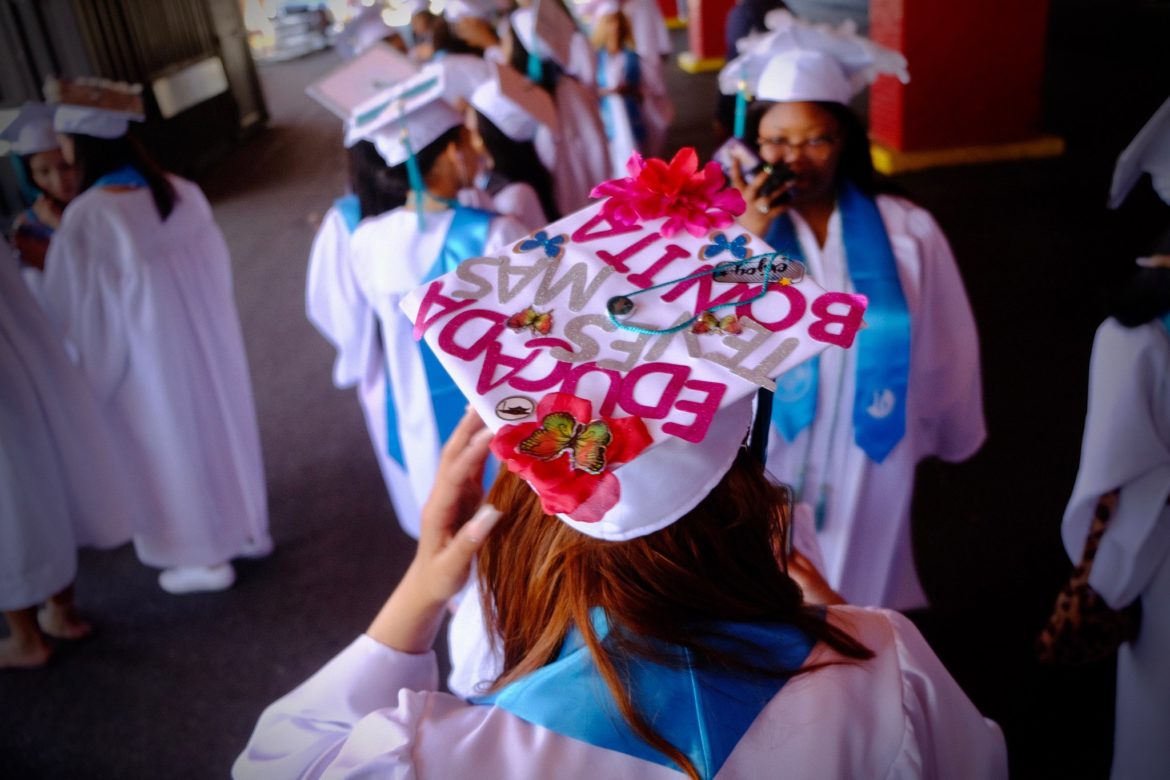Federal law that protects the educational rights of homeless children and youth under 21 says young adults should be enrolled in school immediately, but the city is not meeting this requirement, advocates say. They report newly arrived immigrant youth being placed on waiting lists, told there are no spaces, or advised to take the General Educational Development (GED) high school equivalency test instead.

Adi Talwar
Early evening at Safe Horizon’s Streetwork Project, a drop-in center for homeless youth in February. The organization says it has referred around 60 cases of migrants directly to the New York City Public Schools (NYCPS) since January, but only six have been enrolled so far.Lea la versión en español aquí.
The 20-year-old from Mauritania arrived in the city four months ago with the dream of graduating from high school in the United States.
“I want to make my life better. I am still a baby, and I should go to school to have more experience, to have more knowledge,” the youth—who preferred not to be identified by name, citing past experiences with other media—said in fluent English, something he quickly picked up from daily interactions, adding to the multitude of languages he already speaks. “I don’t want to lose my time.”
In only four months, he has moved from one shelter to the other: living first in Manhattan, then Brooklyn, and now the Bronx, after the city instituted a 30-day shelter limit for adult migrants in the city last year, which was extended last week to 60 days for adults under 23 as part of the city’s “right to shelter” settlement.
Over 852 single immigrant youth between the ages of 17 and 20 were in the city’s shelter system as of March 3, according to City Hall. Dozens of them have told shelter staff they want to graduate from high school, but haven’t been enrolled—even though they are entitled to do so under federal law, according to several community-based organizations (CBOs) that are trying to assist them.
Eight local organizations that provide services to immigrants and/or youth described delays and difficulties in enrolling young migrants recently. The organization with the highest number of cases was Safe Horizon’s Streetwork Project, a drop-in center for homeless youth that has been serving an increasing number of asylum seekers since last year, which says it has referred around 60 cases of migrants directly to the New York City Public Schools (NYCPS) since January.
But only six have been enrolled so far, lamented Sebastien Vante, associate vice president of Safe Horizon’s Streetwork Project in Harlem.
Other organizations—Afrikana, an East Harlem community center that serves young immigrants; Artists Athletes Activists, which greets asylum seekers upon arrival and connects them with support services; the Coalition for Homeless Youth; The Door, which offers legal aid, counseling, and various support services to youth; and the New York Legal Assistance Group—told City Limits that the youth they serve have faced difficulties in school enrollment.
Some have been told there is no space, some have been put on waitlists and others said they were only given the option of taking the General Educational Development (GED) high school equivalency test, according to these groups.
When asked about these complaints, a New York City Public Schools spokesperson said the education department “does not track enrollment referrals and students are not asked to disclose how they received information about the enrollment process.”
“Enrollment does not work on a referral basis,” added the spokesperson in an email.
The department said it is working to ensure that older students who want to attend classes are afforded academic options including traditional high schools, transfer schools—which serve students who are behind in credits or need alternative forms of education—as well as adult GED programs.
“Since the inception of Project Open Arms, we have made it clear—we cannot do this work alone,” the spokesperson said in a statement, referring to the city’s initiative to offer educational support to new immigrants and asylum seekers.
But stating now that enrollment does not operate on a referral basis, advocates said, has created confusion, departing from how the city has historically enrolled unhoused young people referred by social services organizations.
“Providers have always utilized certain processes through relationships with students in temporary housing liaisons,” countered Jamie Powlovich, executive director for the Coalition for Homeless Youth. “If that process is no longer something NYC Public School supports, they didn’t tell anyone.”
Under the McKinney-Vento Act, a federal law that protects the educational rights of homeless children and youth, these young adults should be enrolled in school immediately, even in the absence of documentation such as proof of residency, immunizations, school records, or other documents normally required.
The New York State Education Law stipulates that those between the ages of 5 and 21 who have not received a high school diploma are “entitled to attend the public schools maintained in the district in which such person resides without the payment of tuition.”
Further, State Education Department guidance notes that, “Districts may not force such individuals to forego a full-time high school program to pursue this alternative option [GED test], or otherwise steer such individuals toward this alternative option.”
“I feel like almost all my clients in that specific situation—17 to 20, trying to get into high school—are almost always pushed towards the GED program,” said Salina Guzman, immigrant youth advocate at The Door. “I think very often, there are many barriers that our clients face when trying to get into high school.”
Since July 2022, about 36,000 students in temporary housing have enrolled in city schools, according to NYCPS, though the agency could not detail how many of them were aged 17-21.*

Adi Talwar
Outside the offices of Afrikana last fall, a community center in East Harlem that’s been helping young immigrants navigate the city’s shelter system, as well as school enrollment.To enroll, the department stated, prospective students must go through a Family Welcome Center, with locations in each of the five boroughs to handle year-round registration and admissions to traditional high schools.*
But advocates say many immigrant youth have learned the hard way that they needed an appointment at these sites before showing up.
“[It] doesn’t sound like a huge issue,” said Rita Rodriguez-Engberg, director of the Immigrant Students Rights Project at Advocates for Children of New York. “But if you’re brand new to the country, and you’re already very confused and trying to make a lot of pieces fit together, and make the trip to the Family Welcome Center, and they tell you that you can’t be there, that you have to go back—that might be a reason alone why a family decides to just stop trying.”
A NYCPS spokesperson disputed that appointments are required at Family Welcome Centers, saying they are recommended but that walk-ins are accepted too. Welcome Centers can also provide referrals to students interested in transfer schools, but for other pathways to graduation, such as adult education programs, prospective students should visit a referral center instead, the spokesperson said.*
But migrants who do make appointments at these welcome centers are sometimes told there is no space or they have to go on a waiting list, advocates say.
In an email, a NYCPS spokesperson acknowledged the presence of waitlists at some of its Welcome Centers—one in Downtown Brooklyn, for example, had less than 20 students waiting at the time of publication—but said names are taken off those lists daily thanks to rolling admissions, and that prospective students have the option of applying through other enrollment centers if their local spot is full.
But advocates say what should be a relatively smooth process now takes several weeks to a little over a month, and depends on a variety of circumstances: available seats, the type of school (transfer school, international high school, etc.), the needs of the student, and the time of year.
“The biggest problem: there’s no room in GED or high school alternatives,” explained Chia Chia Wang, NY Director of Church World Service (CWS), an organization that works with unaccompanied children who have come to reunite with their family members, which has been assisting many young people who are 17 or older with enrollment.
A CWS case manager explained that it took a month for one migrant, who will turn 18 in April and is living in a youth shelter without a guardian, to be enrolled after visiting the Family Welcome Center and being placed on a waiting list. “Despite reaching out to several transfer schools, he remained on waiting lists,” the caseworker said in an email.
“His absence from an educational environment,” the case manager added, “was starting to impact his mental well-being, as he expressed feeling down while observing his friends attending school while he remained at the shelter.”
To enroll migrants, advocates have made appointments, visited the Family Welcome Center, and called a bunch of high schools directly. “And that’s how, you know, we get students in school,” described Rodriguez-Engberg.
But according to the law, and reiterated by both the U.S. Department of Education and the NYS Department of Education, enrollment should be immediate. A U.S. Department of Education spokesperson said that anyone who meets the eligibility requirements and who is identified as homeless by a local liaison that serves students in temporary housing and their families in schools, should be able to attend classes right away.
A spokesperson for the New York State Education Department (NYSED) said that NYCPS has not reported any difficulties, delays, or problems in enrolling immigrant students in this age group, nor in failing to enroll them promptly, as required by the McKinney-Vento Act. NYSED would provide direct technical assistance to ensure compliance, added the spokesperson.
As a recipient of McKinney-Vento funds, the NYCPS has submitted proposals and annual reports ensuring compliance with the act, NYSED explained.
The New York State Attorney General’s Office encourages people who have been denied enrollment to contact its office or to file a Civil Rights Bureau complaint form.

Gerardo Romo/NYC Council Media Unit
NYC high school graduates at a 2019 ceremony in Brooklyn.Aging out of classrooms
An applicant approaching 18 complicates enrollment, several advocates explained. Turning 18 often makes it even harder.
“I had difficulty enrolling a client that was 17 and a half,” a Church World Service caseworker said via email. “The family was told that he was going to be 18 years old soon and that he should go to take a GED program instead of enrolling him in high school.”
The two young men City Limits spoke to during a visit to the Safe Horizons drop-in center in Harlem, one 20 and the other 18, said they had both asked staff at their shelters to be enrolled in school, to no avail. Nor were they referred to a family welcome center.
The young man from Mauritania said he did not persist or revisit the request because, under the city’s previous 30-day stay limit rules for adult migrants, it would be too difficult to fully focus on his studies without a stable place to live.
“So if I finished that one month, I should wait two weeks—three weeks, or one week, whatever—to get a shelter. I cannot sleep in a church, or sleep in a mosque, and then wake in the morning and go to school and come back tired,” he said.
CBOs told City Limits this age group easily falls through the cracks of the city’s shelter system and tends to be perceived as adults, not as young adults or unaccompanied youth.
“For newly arrived migrant youth of that age group—17 to 20—it’s rare that somebody will identify them as a [school-age] student, as a youth who needs to be in school,” Rodriguez-Engberg said. “They’re looked at as like adults, or they’re overlooked, period.”
Many young adults are entering adult shelters, where it’s harder to access the programs designed to help them.
Young people under the age of 24 are eligible for specialized runaway and homeless youth shelters under the Department of Youth and Community Development (DYCD), but with only 813 beds, it has long been near or at capacity. In addition to school enrollment assistance, these shelters provide mental health services, access to legal aid, job training, and other services.
After two years of new immigrants arriving from all over the world, organizations say it’s hard to know the magnitude of the problem: how many young people who could be enrolled who are not in school right now, and how their lives could have been changed with such access.
“A bigger problem is the fact that we don’t really even know what the actual need is,” Rodriguez-Engberg said. “How many are there actually, who just gave up and are working or trying to do something else, because they had no idea they could be in school.”
In 2020, the Migration Policy Institute estimated that 3,800 newly arrived immigrants in New York City, ages 16 to 21, were neither enrolled in city schools nor had a diploma.
While NYCPS expanded programs for new immigrants enrolled in the city’s transfer high schools in 2022, the same year that more immigrants began arriving in the city, advocates say it’s still not enough to keep up with demand.
Enrollment challenges have affected both young adults living alone in the city as well as those living with their families. “The problem that exists with the lack of options and the Family Welcome Centers referring students to GED programs, happens regardless of whether the student is here alone or they’re here with their family,” Rodriguez-Engberg explained.
The youngest, those between 17 to 19, advocates explain, have a better chance and more time to navigate the laborious enrollment process, but for older youth, time is limited, since federal law only guarantees their right to attend through age 21.
“Every beginning is hard, but in the end, it’s going to be okay, but we don’t want to lose time,” the young man from Mauritania told a City Limits reporter. “We’re not allowed to work, so we should go to school to get information. If we were allowed to work, that information can help us in the future.”
He cited his own multilingual skills as something he and many other immigrant youth can offer the local job market—if they can access it.
“Maybe, the U.S. is going to need us one day,” he said.
*This story has been updated since original publication to include additional information provided by NYCPS.
To reach the reporter behind this story, contact Daniel@citylimits.flywheelstaging.com. To reach the editor, contact Jeanmarie@citylimits.flywheelstaging.com
Want to republish this story? Find City Limits’ reprint policy here.








